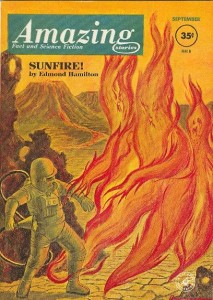
Sunfire by Edmond Hamilton may not be as recognizable as some of the other classic short stories reviewed here from the 1969 The Best of Amazing, but it was selected by Editor Joseph Ross for a very good reason. Hamilton’s first Amazing Stories publication came back in January 1928 (The Comet Doom), but the story Sunfire first appeared over 34 years later in the September 1962 issue of Amazing Stories. Even after a third of a century, Hamilton maintained the fresh literary style founder Hugo Gernsback envisioned and allowed readers to enjoy the modern perspective of a classic theme. Most importantly, it makes the reader think.
The story revolves around the mysterious resignation of Hugh Kellard, a member of the space exploration company Survey. The lone survivor after a three man mission crashes on Mercury at a place called Sunside; Kellard suddenly gives up on a lifelong dream of reaching for the stars. The accident would have rattled anybody who survived such an ordeal, but there is something more to this sudden change of attitude.
“Funny, he thought. When I was a boy sitting here dreaming about the future and what I was going to do, I never once imagined that some things would stay much the same. The whole world would somehow be miraculously transformed – but it wasn’t. This tree was here when men first reached the Moon, and Mars, and Venus and the rest, but it didn’t know about that; it didn’t change because of it.”
Kellard talks of man’s need to own the stars. It is as if the constant drive to journey further and further is primarily based on the need to conquer. In turn, this possession is what makes man the center of everything. But at Sunside, Kellard’s meaning of life is proven flawed.
“Back in your time, there were hopes, and dreams, and man’s road would go on forever, from triumph to triumph everlasting. But that road was a blind alley, all the time, even if I’m the only one who knows it.”
To some, this blindfolded approach of withholding evidence is a poor literary technique. In most cases, saving the truth for a climactic finish is indeed an amateurish practice worthy of being wadded up and tossed into the rubbish bin. But in this story, the entire theme is based on the fact that Kellard is hiding the truth from his colleagues. To the observant reader, the secret is not as important as the motive behind it.

Though difficult as it may be, there will be no spoilers here – with the hopes that you will one day find this short gem and read it for yourself. As I re-read this review, I can’t help but feel the ghost of irony looking over my shoulder, pointing at my own ambiguity, and I hope this blog does not ironically end up in the same rubbish bin for holding back too much. But hey, just like space travel, most of the fun is in the journey.
Sunfire is a quick read with a lot to say. Edmond Hamilton not only withstood the changes in time while continuing the Amazing Stories tradition of thought provoking literature, the author keeps the reader guessing. You may not be surprised or in awe by what you discover in the end, but you will be thinking about it long after you’ve turned the last page.










